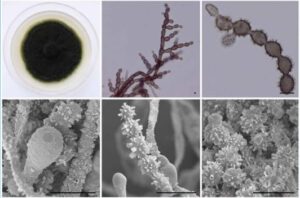Kosmimatomyces alatophylus Bianchin., Reinoso-Fuentealba, Rodr.-Andr., Cano & Stchigel, in Crous et al., Persoonia 44: 403 (2020)
Index Fungorum number: IF 836059; FacesofFungi number:FoF 11050
Etymology: From Greek αλατος-, salt, and -φιλος, lover, because of the environment from which the fungus was recovered.
Mycelium consisting of branched, septate, thick-walled, 2.5–4.5 µm wide hyphae. Conidiophores solitary, macronematous or semimacronematous, erect, straight to flexuous, from hyaline to dark brown, thick- and smooth-walled to verrucose along its length, branched or unbranched, branches terminal or lateral, in an angle 45 to 90°, 13–100 × 3.5–6 µm. Conidiogenous cells determinate, integrated, terminal or intercalary, pale to dark brown, verrucose, mono- or polyblastic, 8‒12 × 5–7.5 µm, scars truncate of 2–3.5 µm wide. Ramoconidia aseptate, pale to dark brown, thick- and smooth-walled to verrucose, subcylindrical,
8.5–25 × 3–6 µm. Conidia 0–1-septate, brown to dark brown, thick-walled, with a spinulose, digitate, pustulate to crater-like ornamentation, globose, limoniform to ovoid or ellipsoid, 6–11 × 5–10 µm, with one or more notorious scars, arranged in branching acropetal chains, of schizolytic secession.
Culture characteristics — (after 2 wk in darkness at 25 °C). Colonies on oatmeal agar (OA) up to 37 mm diam, flat, slightly dusty to floccose, greyish sepia (Rayner 1970), aerial mycelium scarce, margins entire, exudates as olivaceous brown; reverse black, diffusible pigments absent. Colonies on potato dextrose agar (PDA) up to 39 mm diam, flat, velvety, radiate and sulcate, greyish sepia at centre, greyish white to the borders, margins regular, scarce droplets of olivaceous exudates; reverse olive black to greyish sepia, diffusible pigments absent. On malt extract agar (MEA) up to 34 mm diam, velvety, zonate, radially folded and somewhat elevated, pale olivaceous grey, mostly consisting of vegetative mycelium, margins irregular; reverse greenish black, diffusible pigments absent. On potato carrot agar (PCA) up to 41 mm diam, floccose, olivaceous black, radiate, margin filamentous; reverse olivaceous black, diffusible pigments absent. On SNA up to 40 mm diam, flat, radiate, olivaceous at the centre and isabelline to the margins, margin entire; reverse olivaceous black at the centre, borders olive, diffusible pigments absent.
Typus – Argentina,Buenos Aires province, Salitral de laVidriera, S38 44.816 W62 33.251, from soil collected in a saltmarsh, 28 Aug. 2015, C.G. Reinoso Fuentealba & M.V. Bianchinotti (holotype CBS H-24325, culture ex-type FMR 15091; ITS and LSU sequences GenBank LR588887 and LR588888, MycoBank MB833528).
Notes — Kosmimatamyces is a new genus that groups in the Capnodiaceae, a family whose members are known as sooty molds whose dark hyphae cover the surface of living leaves and twigs of many plants (Hughes 1976, Abdollahzadeh et al. 2020). Hypersaline soil represents a new ecological niche, reinforcing the hypothesis of Crous et al. (2009) and Chomnunti et al. (2011) that plant surfaces are not the only environmental niche for this group of fungi. Based on a megablast search of NCBIs GenBank nucleotide database, the closest hit using the ITS sequence was Microxiphium theae CBS 202.30 (GenBank MH855113; identities = 475/514 (92 %), 11 gaps (2 %)), Antennariella placitae AS01 (GenBank MG583755; Identities = 472/511 (92 %), 11 gaps (2 %)), and Leptoxyphium kurandae MCC1085 (GenBank KF826942; Identities = 470/510 (92 %), 9 gaps (2 %)); using the LSU sequence, the closest hit was Capnodium coartatum MFLUCC10-0066 (GenBank JN832613; Identities = 547/555 (99 %), no gaps), Microxyphium aciculiforme CBS 892.73 (GenBank GU301847; Identities = 547/555 (99 %), no gaps), and Conidioxyphium gardeniorum CPC 14327 (GenBankGU301807; Identities = 547/ 555 (99 %), no gaps). The LSU phylogenetic tree corroborated the placement of our isolate close to the genus Leptoxyphium. The species of Leptoxyphium are characterised by pycnidial conidiomata with a bulbous swollen base and cylindrical neck that expands at the apex to become funnel-shaped (Hughes 1976, Chomnunti et al. 2011), whereas Kosmimatamyces produces single conidiophores.

Figure 1. Kosmimatamyces alatophylus, Salitral de la Vidriera. Colony on OAat 2 wk; conidiophores, conidiogenous cells and conidia. Scale bar = 10 µm.
